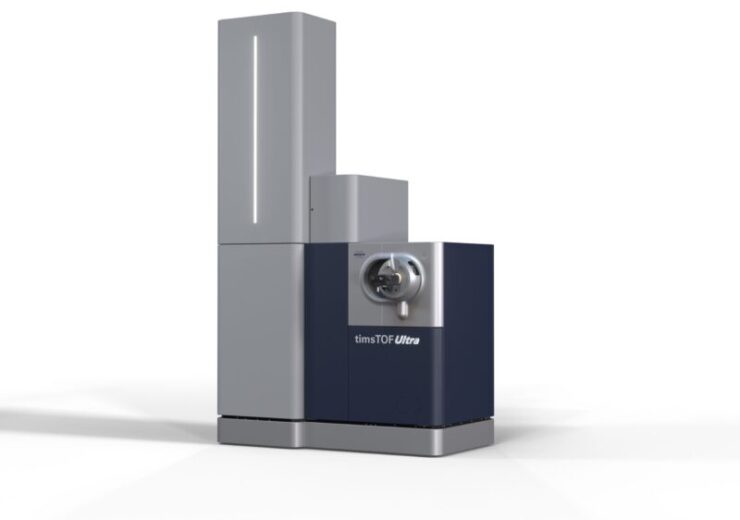According to the company, timsTOF Ultra consists of a new CSI Ultra ion source along with a larger capillary and optimised vortex gas flow, a fourth-generation TIMS XR cell, and a 14bit digitiser

Product image of timsTOF Ultra mass spectrometer. (Credit: Business Wire/Bruker Corporation)
US-based manufacturing company Bruker has introduced the new timsTOF Ultra mass spectrometer with 300 Hz PASEF MS/MS, and VistaScan for enhanced dia-PASEF 4D-Proteomics.
timsTOF Ultra consists of a new captive spray ionisation (CSI) Ultra ion source along with larger capillary and optimised vortex gas flow, a fourth-generation TIMS (trapped ion mobility separation) XR cell, and 14bit digitiser.
The spectrometer is designed to detect more than 55K peptides that map into 5,000 protein groups at the single-cell level of 0.125 ng protein loading, at lesser than a 1% false discovery rate (FDR). It can also find around 4,800 protein groups quantified at CVs of under 20%.
According to Bruker, the system now offers enhanced sensitivity and quantitation performance below the 1 ng protein load level.
It is said to have a new PASEF scan speed of up to 300 Hz for MS/MS, improving performance for ultra-low sample amounts like unbiased single-cell proteomics and single-cell lipidomics, unbiased spatial proteomics, PTM analysis, and protein-protein interaction (PPI) studies.
Max Delbruck Center, Berlin, Germany spatial proteomics group leader Fabian Coscia said: “The single-cell sensitivity dia-PASEF workflow on the timsTOF Ultra has brought our low-input tissue proteomics research to a new level.
“Using a 20-min nanoflow LC gradient combined with Bruker’s optimized dia-PASEF (3×8 window) method, we can now reproducibly quantify 1,500 – 2,000 proteins from laser micro-dissected mouse liver FFPE tissue of only 1,500 µm2, regions corresponding to approximately 1-2 hepatocytes.”
The timsTOF Ultra advancements were made without sacrificing the robustness for high-throughput proteomics, such as at 50 samples per day (SPD) or even up to 398 SPD, or the highest identification confidence of 1% peptide and 1% protein FDRs, said the company.
Additionally, the VistaScan software has been launched for synchronising the TIMS ramp with the quadrupole scan to use ion mobility information at scale.
The dynamically linked ramp supports the midia-PASEF mode, which Bruker licensed exclusively from Johannes Gutenberg University Mainz.
Furthermore, the timsTOF Ultra mass spectrometer has an improved dda-PASEF acquisition mode.
This enhances the speed to 300 Hz for up to 18,000 collision cross-section (CCS)-enabled MS/MS spectra per minute for in-depth 4D-Proteomics and 4D-Lipidomics / 4D-Metabolomics with very short LC gradients of just minutes, the manufacturing firm added.
Bruker also optimised the CSI Ultra ion source for the timsTOF Ultra by focussing the vortex gas at the nanospray tip to advance ion transmission. The vortex maintains ionisation in gradients for flow rates of 50-5000 nL/min.
